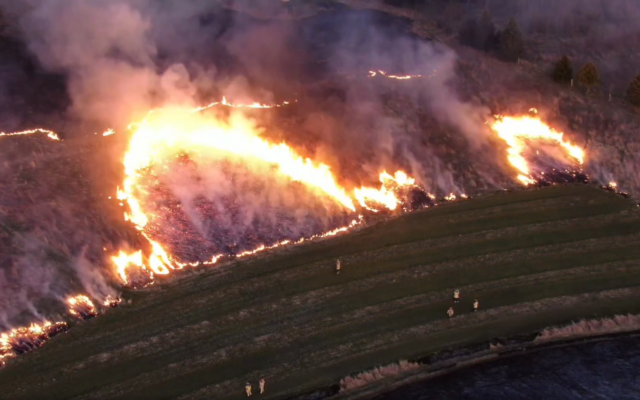U.S. closing 6 makeshift housing sites for unaccompanied children

Starting Wednesday, the Biden administration is set to begin closing six emergency housing facilities it stood up in Texas and California this spring to accommodate the record number of unaccompanied children who were entering U.S. custody along the border, the Department of Health and Human Services (HHS) confirmed to CBS News.
HHS plans to officially discontinue emergency housing sites at Lackland Airforce Base in the San Antonio area and a former camp for oil workers in Midland, Texas, on Wednesday. Two other makeshift shelters in Carrizo Springs and Donna, Texas, are scheduled to close on July 19.
Convention centers in San Diego and Long Beach, California, are slated to stop housing unaccompanied children on July 15 and August 2, respectively, the department said.
The planned closures of the six sites comes as the number of unaccompanied children in U.S. government custody has slowly decreased due to declining border apprehensions and efforts to expedite the release of children to family members in the U.S.
There were 14,400 unaccompanied minors in HHS care on Tuesday, a 35% drop from early May, when the department was housing more than 22,000 minors. In May, U.S. border officials encountered 14,200 unaccompanied children, down 25% from the record monthly high in March.
The number of unaccompanied children held at the emergency sites — which have lower standards of care and services than traditional HHS shelters — has also decreased.
As of Tuesday, 6,100 minors — or 42% of the children in HHS care — were being held at the emergency and influx facilities, according to internal government documents obtained by CBS News. In mid-May, the emergency sites were housing 13,000 children, or 65% of the overall population at the time.
Approximately 8,300 children were being housed in HHS’ traditional shelters and foster care programs, which are licensed to care for minors, unlike the emergency facilities, the documents show.
According to the “Operation Artemis” documents, children are spending an average of 37 days in HHS care. Operation Artemis is the Biden administration’s inter-agency effort to process unaccompanied children. In the past seven days, the department placed more than 3,600 children with sponsors in the U.S.
HHS set up more than a dozen “emergency intake sites” this spring to get unaccompanied young people out of ill-suited Border Patrol holding facilities, which were severely overcrowded in March and early April.
In May, HHS shuttered two of those sites, including a warehouse in Houston that was closed because of inadequate living conditions endured by the migrant girls held there. The Kay Bailey Hutchison Convention Center in Dallas and San Antonio’s Freeman Coliseum also stopped housing migrant children that month.
HHS said it would keep four emergency facilities open for the time being. They include a former work camp in Pecos, Texas; a facility for young children in Albion, Michigan; a site in Pomona, California; and a tent camp inside the Fort Bliss U.S. Army base that can accommodate up to 10,000 minors.
Another “influx” housing facility in Carrizo Springs, Texas, that opened in February will also continue to house unaccompanied youth, HHS said. Overall, HHS wants to have at least 25,000 beds available for migrant children to meet a potential “surge demand,” according to the Operation Artemis documents.
The Fort Bliss site has come under scrutiny in recent weeks due to CBS News reported of subpar conditions and distress among the teenagers held there. CBS News reported earlier this month that children have attempted to escape the facility, while others have been constantly monitored for panic attacks and self-harm.
The number of children at Fort Bliss has recently plummeted, dropping below 800 this week after reaching 4,500 last month. HHS has also touted efforts to improve conditions and services at the site, which is located in the west Texas desert.
Case management and mental health services at the tent camp have been expanded, HHS has said. Children there are now sleeping on single cots, rather than bunk cots. The facility is also no longer housing migrant girls.
During a call with reporters Monday, HHS Secretary Xavier Becerra said his department was reviewing which emergency sites it could close. But he stressed that some emergency bed capacity would be necessary for the time being to ensure that children continued to be expeditiously transferred out of Customs and Border Protection (CBP) custody.
“We want to make sure that we are prepared for any outcome in terms of the number of children,” Becerra said. “So we have to be prepared. We don’t want to see CBP become overcrowded again with children who should not be in adult detention facilities.”
Becerra added that HHS is working to expand space at its traditional shelters, which he noted are still operating under limited capacity due to COVID-19 mitigation measures.
Leecia Welch, an attorney who represents migrant minors in a landmark federal court case, welcomed the planned closures of the emergency sites. But she expressed concern about some children continuing to spend prolonged periods of time in HHS custody.
“We are cautiously optimistic about the efforts underway to close some emergency sites and address the size and serious concerns being raised about others, like Fort Bliss, where the accounts of children’s suffering have been unprecedented,” Welch, who works at the National Center for Youth Law, told CBS News. “But we will remain on high alert until we see a significant improvement in the conditions and length of time children are staying at these sites.”



